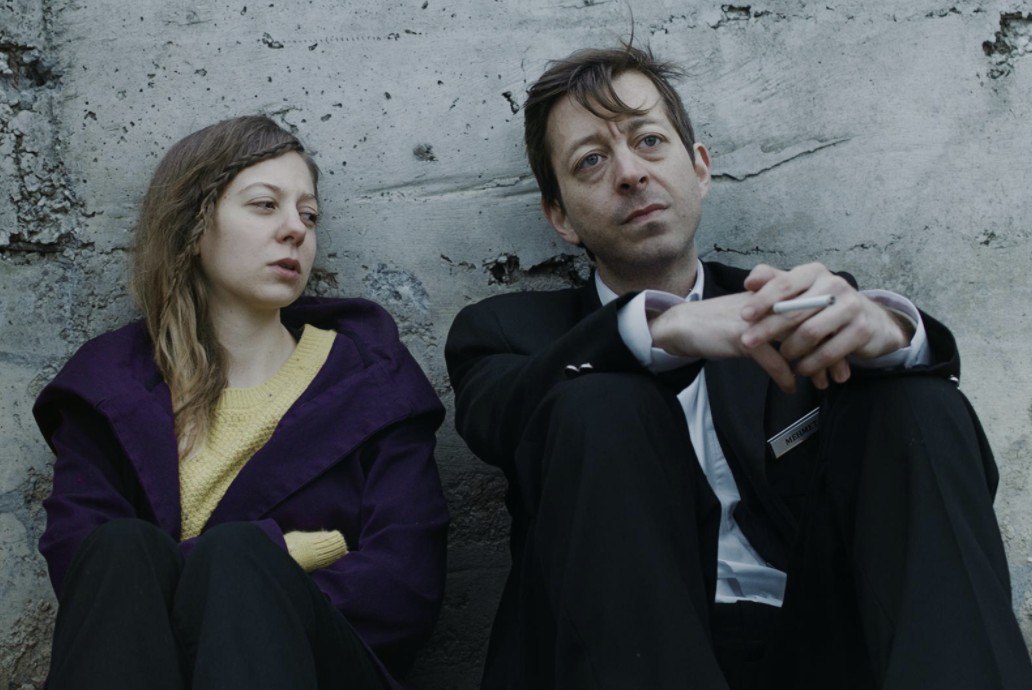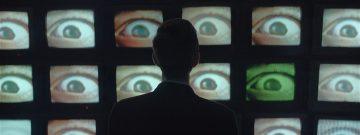by Alexander C. Kafka

What do you get when you combine unrelenting nihilism with art-school swagger? The Antenna, the first feature film of Turkish writer-director Orçun Behram, a 2011 graduate of Columbia College Chicago who until now has worked on music videos, short films, and documentaries.
Ihsan Önal plays a heavy lidded, bug-eyed building superintendent named Mehmet. A dour insomniac prone to work-shift napping, he looks like Paul McCartney fused with Peter Lorre and Mr. Bean. Mehmet oversees, or rather undersees from a ground-floor observation booth, a towering apartment building on a windy tundra during an unspecified but late 70s/early 80s looking era. Mehmet is resigned to a pitiful life — “One also gets used to rotting,” he says to his teenage confidante, Yasemin (Gül Arici). He gives her a ticket to escape, though. In a stultified world, she has a wall of Post-it notes and push pins with strings attached — ideas, we deduce, that could take her places.
Mehmet’s bully of a boss, Cihan (Levent Ünsal), informs him that a government worker will install a mandatory dish antenna atop the building to carry a station that issues directives and bulletins. The insidiousness of the Orwellian project is clear from early on — not just an installation mishap but a dark sludgy goo that seeps supernaturally from the device into the structure below. It is, we learn, part of a wider multimedia takeover that encompasses radio and print as well.
The unsubtle nod to Recep Tayyip Erdoğan’s increasingly authoritarian Turkey has an undeniable impact. “Day by day, we are getting closer to the ideal order,” the TV reader incants. “Any breaches of the order are hastily being eliminated. It is now time to act as a single body. We will be with you forever. Our voice is your voice. Power is our fate. If you think something is going wrong, you are mistaken.”
But The Antenna is overly obvious in its dual, somewhat clashing metaphors — either broadcast or sludge can carry their narrative weight, and using both tropes puts them in unconstructive competition with each other. Nor does the film even pretend to flesh out its characters. They are semi-anonymous types, creatures to whom things are meant to happen.
But so what. As it spelunks through boiler rooms and bathrooms, the film is a gruesome joy to watch because of Behram’s sheer pleasure at finally getting to pay two hours of oh-so-carefully arranged homage to his evident heroes.
Among those are certainly modern horror masters. The tube-TV totalitarianism is a dry afterglow from Cronenberg’s libidinous Videodrome, with hints of Poltergeist. And one half expects Jack Nicholson to peer around a Kubrick corner of the claustrophobic, ghoulishly animate hallways and apartments, with their shuddering pipes and drippy faucets. I wondered if it was an infamous spilled-milk scene in John Schesinger’s 1987 The Believers that sparked another demise savagely staged by Behram. More matinee-ishly, the toxicity of dripping sludge salutes two generations of The Blob.

Behram doesn’t go for perversely flippant Hollywood quips, however. When terrified children cower wide-eyed behind locked doors, there are no “Here’s Johnny!” sneers from their unhinged parents. Indeed, the camera’s tense stillness, the carefully hideous decors of drab living rooms, hark back to more fundamental cultural history: the soulless, captured creatures of Bunuel, and his surreally obsessive closeups of the eye; the lost, floating, faceless nonentities of Magritte.
But perhaps Behram’s chief asset is his command of time. In a quick-cut world, he lets us stew in long takes with little dialogue. In his shot composition, he plays with the elongated rectangle of the wide screen, for instance as we observe Mehmet through his own observation window. The combined temporal and visual elongation are a meta-metaphor for the surveillance state that he depicts. Co-conspiring are Can Demirci, creator of a throbbing ambient score with bursts of Dario Argento-era tech pop, and Ismail Hakki Hafiz, concocter of the sublimely slimy sound design.
In a memorable sequence, Mehmet’s sanity is pushed to the brink in a hallway full of radios embedded into the walls. They throb with authoritarian pronouncements. On one hand, it’s a timely reflection of contemporary society’s right-leaning ugliness. On the other hand, spooky strobed lighting and multi-layered, panning sound are so lovingly compiled that it also feels like the capstone art installation of an elated M.F.A. student.
That is to say that although Behram’s vision is grim, it’s wonderfully colorful too and a creative flipped finger against the very dictatorial trends he depicts. He has yet to refine his message, but The Antenna signals many chilly pleasures ahead from this gifted young director.
